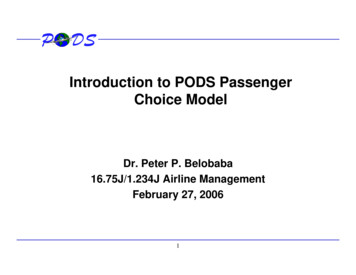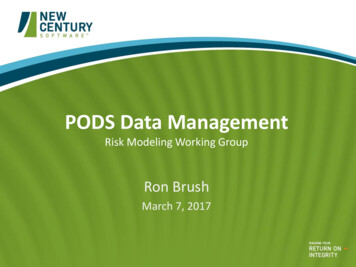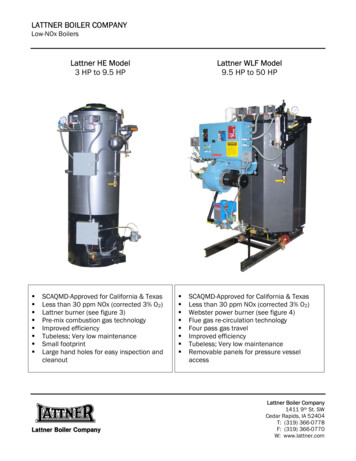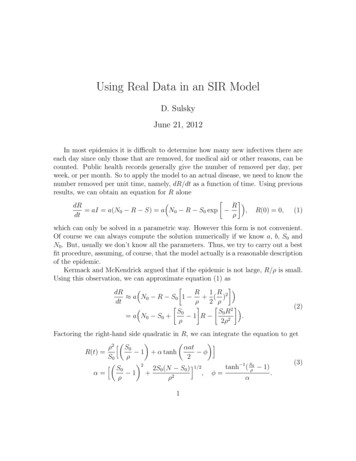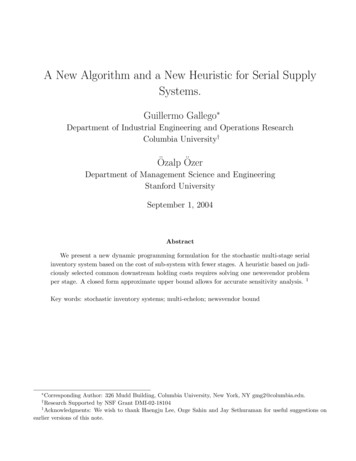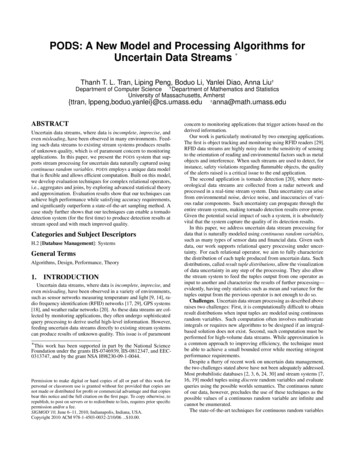
Transcription
PODS: A New Model and Processing Algorithms forUncertain Data Streams Thanh T. L. Tran, Liping Peng, Boduo Li, Yanlei Diao, Anna Liu†Department of Computer Science † Department of Mathematics and StatisticsUniversity of Massachusetts, Amherst{ttran, lppeng,boduo,yanlei}@cs.umass.eduABSTRACTUncertain data streams, where data is incomplete, imprecise, andeven misleading, have been observed in many environments. Feeding such data streams to existing stream systems produces resultsof unknown quality, which is of paramount concern to monitoringapplications. In this paper, we present the PODS system that supports stream processing for uncertain data naturally captured usingcontinuous random variables. PODS employs a unique data modelthat is flexible and allows efficient computation. Built on this model,we develop evaluation techniques for complex relational operators,i.e., aggregates and joins, by exploring advanced statistical theoryand approximation. Evaluation results show that our techniques canachieve high performance while satisfying accuracy requirements,and significantly outperform a state-of-the-art sampling method. Acase study further shows that our techniques can enable a tornadodetection system (for the first time) to produce detection results atstream speed and with much improved quality.Categories and Subject DescriptorsH.2 [Database Management]: SystemsGeneral TermsAlgorithms, Design, Performance, Theory1.INTRODUCTIONUncertain data streams, where data is incomplete, imprecise, andeven misleading, have been observed in a variety of environments,such as sensor networks measuring temperature and light [9, 14], radio frequency identification (RFID) networks [17, 29], GPS systems[18], and weather radar networks [20]. As these data streams are collected by monitoring applications, they often undergo sophisticatedquery processing to derive useful high-level information. However,feeding uncertain data streams directly to existing stream systemscan produce results of unknown quality. This issue is of paramount This work has been supported in part by the National ScienceFoundation under the grants IIS-0746939, IIS-0812347, and EEC0313747, and by the grant NSA H98230-09-1-0044.Permission to make digital or hard copies of all or part of this work forpersonal or classroom use is granted without fee provided that copies arenot made or distributed for profit or commercial advantage and that copiesbear this notice and the full citation on the first page. To copy otherwise, torepublish, to post on servers or to redistribute to lists, requires prior specificpermission and/or a fee.SIGMOD’10, June 6–11, 2010, Indianapolis, Indiana, USA.Copyright 2010 ACM 978-1-4503-0032-2/10/06 . 10.00.†anna@math.umass.educoncern to monitoring applications that trigger actions based on thederived information.Our work is particularly motivated by two emerging applications.The first is object tracking and monitoring using RFID readers [29].RFID data streams are highly noisy due to the sensitivity of sensingto the orientation of reading and environmental factors such as metalobjects and interference. When such streams are used to detect, forinstance, safety violations regarding flammable objects, the qualityof the alerts raised is a critical issue to the end application.The second application is tornado detection [20], where meteorological data streams are collected from a radar network andprocessed in a real-time stream system. Data uncertainty can arisefrom environmental noise, device noise, and inaccuracies of various radar components. Such uncertainty can propagate through theentire stream system, making tornado detection results error-prone.Given the potential social impact of such a system, it is absolutelyvital that the system capture the quality of its detection results.In this paper, we address uncertain data stream processing fordata that is naturally modeled using continuous random variables,such as many types of sensor data and financial data. Given suchdata, our work supports relational query processing under uncertainty. For each relational operator, we aim to fully characterizethe distribution of each tuple produced from uncertain data. Suchdistributions, called result tuple distributions, allow the visualizationof data uncertainty in any step of the processing. They also allowthe stream system to feed the tuples output from one operator asinput to another and characterize the results of further processing—evidently, having only statistics such as mean and variance for thetuples output from the previous operator is not enough to do so.Challenges. Uncertain data stream processing as described aboveraises two challenges: First, it is computationally difficult to obtainresult distributions when input tuples are modeled using continuousrandom variables. Such computation often involves multivariateintegrals or requires new algorithms to be designed if an integralbased solution does not exist. Second, such computation must beperformed for high-volume data streams. While approximation isa common approach to improving efficiency, the technique mustbe able to achieve a small bounded error while meeting stringentperformance requirements.Despite a flurry of recent work on uncertain data management,the two challenges stated above have not been adequately addressed.Most probabilistic databases [2, 3, 6, 24, 30] and stream systems [7,16, 19] model tuples using discrete random variables and evaluatequeries using the possible worlds semantics. The continuous natureof our data, however, precludes the use of these techniques as thepossible values of a continuous random variable are infinite andcannot be enumerated.The state-of-the-art techniques for continuous random variables
employ either multivariate integrals or Monte Carlo simulation. Theintegral-based approach to aggregation [6] performs n-1 integralsto compute the sum of n tuples. While the result is exact, its computation is too slow for stream processing, as we shall show laterin this paper. The Monte Carlo approach [12, 15, 25] samples fromthe input tuple distributions and computes the result tuple distribution from the samples. For real-world data, however, it is difficult,sometimes impossible, to know right the number of samples neededto guarantee both accuracy and efficiency for complex relationaloperations, as we also show in our performance study.Our work presented in this paper originates from our belief thatfor a significant fragment of relational algebra, faster and moreaccurate algorithms are possible. Then these algorithms can be usedto improve existing Monte Carlo systems when queries involve theset of common relational operations that these algorithms support.Scope and contributions. In this paper, we present a PrObabilistic Data Stream system, which we call PODS, that supports relationalprocessing of uncertain data streams modeled using continuous random variables. The architectural design of PODS, as described in[11], is to extend the box-arrow paradigm for stream processing[4] such that tuples carry distributions to describe uncertainty andrelational operators transform these distributions while processingtuples. This paper, in particular, focuses on the data model and processing algorithms for two complex operators, aggregates and joins.1 These operators are crucial to our target applications but havenot been sufficiently addressed. Further in the streaming context,our goal is to perform such complex operations at high speed, e.g.,thousands of tuples per second or higher. More specifically, ourcontributions include:Data model. The foundation of PODS is a unique data modelbased on Gaussian Mixture distributions. This model is highly flexible as it subsumes Gaussian distributions and can model arbitraryreal-world distributions [21]. It further allows efficient computationby exploiting Gaussian properties and powerful statistical methodsfor continuous variables. Most importantly, this model allows aclosed-form solution for a range of relational operations, amongwhich this paper focuses on aggregates and joins, and the resultdistributions of these operations still obey Gaussian Mixture distributions. Our model stands in contrast to those based on histograms[12] and weighted particles [18], which indicate the use of samplesin computation.Aggregates. Our data model empowers us to design novel algorithms for aggregates, such as sum and avg, that are groundedin statistical theory. Our first algorithm obtains exact result distributions of aggregates while completely eliminating the use ofintegrals (in contrast to using multiple integrals in [6]). However,the formulas for result distributions produced by the exact algorithmgrow exponentially in the number of aggregated tuples. Hence, weprovide two approximation methods to simplify the formulas forresult distributions. These techniques, when combined into a hybridsolution, can satisfy arbitrary application accuracy requirementswhile achieving high speed in stream processing.Joins. Our data model also enables efficient, accurate evaluation techniques for joins. We propose two types of joins to suitdifferent application semantics. The first type models equi-joins oncontinuous-valued uncertain attributes as a join of an input streamand a probabilistic view. PODS supports such joins with efficientregression techniques to construct the view and given the view, aclosed-form solution in Gaussian Mixture Models to represent resultdistributions. The second (traditional) type of join pairs tuples from1 We note that our model and algorithms can be generally applied to bothprobabilistic databases and data stream systems where uncertain attributesare modeled by continuous random variables.two inputs for inequality comparison and is modeled by a crossproduct followed by a selection. PODS supports such joins withexact result distributions and methods for pruning tuples with lowexistence probabilities.Evaluation. We perform a thorough evaluation of our techniquesfor joins and aggregates, and compare them with sampling-basedmethods ([12] for aggregates and a home-grown method for joins).Results of this study demonstrate our advantages in both accuracyand speed over the sampling-based methods, due to the use of ourdata model and techniques for continuous random variables.We further perform a case study of tornado detection by feedinga trace collected from a real tornadic event into the PODS system.Our results show that fitting the data to the PODS model and usingits processing techniques to characterize uncertainty enables thetornado detection algorithm (for the first time) to produce detectionresults at stream speed with much improved quality.2.MOTIVATING APPLICATIONSIn this section, we present two motivating applications.2.1Object Tracking and MonitoringIn the first application, radio frequency identification (RFID)readers are used to monitor a large area such as a warehouse, aretail store, or a library. RFID data is known to be highly noisy[17, 29] due to environment factors such as occluding metal objectsand interference. Moreover, mobile RFID readers may read objectsfrom arbitrary angles, hence particularly susceptible to variable readrates. Recent work such as [29] provides techniques to transformraw RFID readings into a stream of location tuples. Each locationtuple contains (Time, Tag id, X p , Y p ), where X p and Y p denotethe inferred location of the object and are probabilistic in nature.Despite the data uncertainty, monitoring applications want torun queries on the location stream to derive high-level information.Query 1 shows an example in fire monitoring: “trigger an alert whena flammable object is exposed to a high temperature.” This querytakes two inputs: a location stream as described above for flammableobjects, and a temperature stream from sensors in the same areawith attributes (Time, Sensor id, X, Y, Temp). The query joins thelocation stream with the temperature stream based on the location.The query is written as if the location of an object were precise.Q1:Select Rstream(R.Tag id, R.X, R.Y, T.Temp)FromFlammableObject [Now] As R,Temperature [Partition By sensor idRows 1] As TWhere T.Temp 60 C andR.X T.X and R.Y T.YQuery 2 detects violations of a shipping policy by the Food andDrug Administration (FDA): “food with and without peanuts cannotbe located closely in the supply chain.” This query takes two locationstreams and checks for the proximity of two types of food.Q2:2.2Select Rstream(R.Tag id, R.X, R.Y, S.Tag id)FromPeanutFreeFood [Range 3 minutes] As R,PeanutFood [Range 3 minutes] As SWhere R.X - S.X 3 ft and R.Y - S.Y 3 ftHazardous Weather MonitoringThe CASA Research Center is developing weather radar networksto detect hazardous weather events such as tornados and storms [20].A four-radar testbed has been deployed in southwestern Oklahoma,a region that receives an average of four tornado warnings and 53thunderstorm warnings each year [20].A CASA radar node rotates to scan. It sends around 2000 pulsesper second, alternating between 54 high frequency pulses and 40
Velocity AnalysisFFTH.F.S.Radar mDetectionFFTwhere 0 pi 1, im 1 pi 1, and each mixture component is aGaussian distribution with mean µi and variance σi2 .Definition 2 A multivariate Gaussian Mixture Model for a randomvector X naturally follows from the definition of multivariate Gaussian flectivity AnalysisA Velocity TupleA Reflectivity TupleH(L).F.S. : High (Low) Frequency SegmentFigure 1: Simplified stream processing in the CASA radar systemlow frequency ones. The raw data stream is partitioned into high andlow frequency stream segments accordingly, and further partitionedbased on the distance to the radar. Overall, the raw data is generatedat 175 Mb per second. Such data is highly noisy due to electronicdevice noise, instability of transmit frequency, quality issues of thesystem clock and the antenna, and finally environmental noise.Such high-volume noisy raw data is fed into a stream processingsystem for real-time weather event detection. The current CASAsystem addresses both data volume and noise issues by means oftaking the average. Fig. 1 shows a simplified diagram of the system.The top box depicts the generation of wind velocity from raw data.This module applies a Fast Fourier Transform (FFT) to each streamsegment for signal processing. It then outputs a single velocityvalue for each stream segment and averages the values for adjacenthigh and low frequency stream segments. The reflectivity analysis,shown in the lower part of Fig. 1, uses similar average operations.While such average operations can reduce data volume and gain asmoothing effect, the resulting data is still highly noisy, causing lowquality detection results and long running time.In our case study (detailed in §6.3), we explore the use of distributions, rather than simple average values, to separate useful data fromnoise while controlling the data volume. The output of our dataanalysis contains tuple streams with distributions (Time, Azimuth,Distance, Velocity p or Re f lectivity p ). We also study the transformation of these distributions through CASA operations, e.g., thefrequently used aggregation operations. By doing so, we expect togain better tornado detection results yet with lower running time.3.THE PODS DATA MODELThe foundation of the PODS system is a data model based on Gaussian Mixture distributions that can capture a variety of uncertaintiesfor continuous-valued attributes and further allow fast relationalprocessing. We describe the PODS data model in this section.3.1Gaussian Mixture Models (GMMs)Gaussian Mixture Models (or distributions), abbreviated as GMMs,are traditionally used for data clustering and density estimation. Asan instance of probability mixture models, a GMM describes aprobability distribution using a convex combination of Gaussiandistributions.Definition 1 A Gaussian Mixture Model for a continuous randomvariable X is a mixture of m Gaussian variables X1 , X2 , · · · , Xm .The probability density function (pdf) of X is:mf X (x) p i f X ( x ),ii 1f Xi ( x ) 1 eσi 2π( x µ i )22σ2i( Xi N (µi , σi2 )), p i f X ( x ),ii 1f Xi ( x ) .Raw Data Seriesf X (x) 1T 11e 2 ( x µi ) Σi ( x µi )(2π )k/2 Σi 1/2(Xi N (µi , Σi )),where k is the size of the random vector, and each mixture componentis a k-variate Gaussian distribution with mean µi and covariancematrix Σi .The PODS system adopts Gaussian Mixture Models due to severalkey benefits of these models. First, GMMs are a natural extensionof Gaussian distributions which are widely used in scientific sensingand financial applications. They can be easily accepted by end userssuch as the CASA scientists with whom we are working.Second, theoretical results have shown that GMMs can approximate any continuous distribution arbitrarily well [21]. Hence, theyare suitable for modeling complex real-world distributions. In thetornado detection application, a detected bimodal distribution ofvelocity at the boundary between a positive velocity area and anegative velocity area is shown in Fig. 2(a). In contrast, Fig. 2(b)shows a velocity distribution in a positive velocity area, where oneGaussian component captures the high concentration of velocity andthe other captures the noise widely spread across the entire spectrum.In the RFID application, Fig. 2(c) shows the inferred location distribution of a recently moved object [29]. Here, the bivariate, bimodalGMM represents the possibilities of the old and new locations usingtwo mixture components; each component is a bivariate Gaussianmodeling the joint distribution of x and y locations.The third benefit of GMMs is efficient computation based onGaussian properties and advanced statistical theory. First, the meanand variance of GMMs can be computed directly from those of themixture components:mE[ X ] p i E [ Xi ](1) pi (Var[Xi ] (E[Xi ])2 ) (E[X ])2(2)i 1mVar [ X ] i 1Furthermore, the cumulative distribution function (cdf) of a GMMwith a single variable has an analytic expression based on a knownerror function. Values of the error function are precomputed in anyRbnumerical library. Hence, computing a f X ( x )dx FX (b)-FX ( a)using the cdf incurs little cost. Other computational benefits ofGMMs, such as the characteristic functions, product distributions,and linear transformation, are described in the later relevant sections.Gaussian Mixture Models can be generated from real-world datain a variety of ways. Recent studies [18, 29] have employed graphical models to infer distributions from noisy raw data. Since thesedistributions are often represented using weighted samples, GMMscan be generated from these samples using standard density estimation or function fitting methods. Time series techniques can alsobe used to generate GMMs from temporally correlated input data. In our case study of tornado detection, a Fast Fourier Transform(FFT) is used to translate a correlated data sequence in the timedomain to an uncorrelated sequence in the frequency domain. Thelatter is essentially a discrete distribution that can be used to fit aGMM, as will be described in §6.3. (See [11] for a discussion ofother techniques that can be employed to generate GMMs.)
(a) CASA: Velocity distribution after FFT in (b) CASA: Velocity distribution after FFT in (c) RFID: Location distribution of a recentlyArea(430, 281.9 ) in a tornadic eventArea(430, 282.3 ) in a tornadic eventmoved object detected using RFID readersFigure 2: Gaussian Mixture Models for real-world data collected from our target applications3.2PODS Data ModelTupleWe now present the complete PODS data model for relationalprocessing. An uncertain data stream is an infinite sequence oftuples that conform to the schema Ad A p . The attributes in Adare deterministic attributes, suc
Data model. The foundation of PODS is a unique data model based on Gaussian Mixture distributions. This model is highly flexi-ble as it subsumes Gaussian distributions and can model arbitrary real-world distributions [21]. It further allows efficient computation by exploiting Gaussian prope

